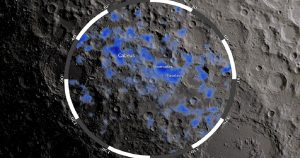
‘Moon Might Be Having More Water Than We Thought’, Says Scientists
With almost assuming that Moon is nothing but a barren land with nothing, just a decade back, various expeditions claimed that the moon has water bodies. It is believed that certain organisms are present there. With no precise idea about the amount of water present, it is simply assumed that Moon definitely has water.
To everyone’s surprise, the Moon, long thought to be a dry, inhospitable orb, hosts surprisingly large sub-surface water reserves, which one day may quench the thirst of lunar explorers from Earth, scientists said Monday.
Shuai Li, co-author of a study by scientists at Brown University in the United States was quoted saying, “We found the signature of the lunar interior water globally using satellite data.”
This postdoctoral researcher at the University of Hawaii and Brown Ph.D. graduate also added that such water can be used as in situ resources for future exploration. Li noted scientists had believed the Moon to be “bone dry” until about a decade ago when scientists found evidence of water in pebble-like beads brought back by Apollo missions.
These findings show numerous volcanic deposits distributed across the surface of the Moon contain “unusually high amounts of trapped water” compared with the surrounding terrain. However, they say the discovery of water in the ancient deposits, which are believed to consist of glass beads formed by the explosive eruption of magma from beneath the Moon’s surface, boosts the idea that the lunar mantle is surprisingly water-rich absolutely.
Ralph Milliken, lead author of the new research, published in the Nature Geoscience journal on Monday said, “The key question is whether those Apollo samples represent the bulk conditions of the lunar interior or instead represent unusual or perhaps anomalous water-rich regions within an otherwise ‘dry’ mantle.”
“The distribution of these water-rich deposits is the key thing, they’re spread across the surface, which tells us that the water found in the Apollo samples isn’t a one-off,” said Milliken.
On the other hand, an associate professor at Brown’s Department of Earth, Environmental and Planetary Sciences mentioned, “by looking at the orbital data, we can examine the large pyroclastic deposits on the Moon that were never sampled by the Apollo or (Soviet) Luna missions. The fact that nearly all of them exhibit signatures of water suggests that the Apollo samples are not anomalous, so it may be that the bulk interior of the Moon is wet.”
According to the recent sources, scientists now believe the Moon formed from debris left behind after an object about the size of Mars slammed into the Earth early in solar system history. They had assumed it was unlikely that any of the hydrogen needed to form water could have survived the heat of that impact.
“The growing evidence for water inside the Moon suggests that water did somehow survive, or that it was brought in shortly after the impact by asteroids or comets before the Moon had completely solidified,” said Li. And, the volcanic beads contain only tiny amounts of water but the deposits are large and the water could potentially be extracted later.
“Other studies have suggested the presence of water ice in shadowed regions at the lunar poles, but the pyroclastic deposits are at locations that may be easier to access, anything that helps save future lunar explorers from having to bring lots of water from home is a big step forward, and our results suggest a new alternative” concluded Li.